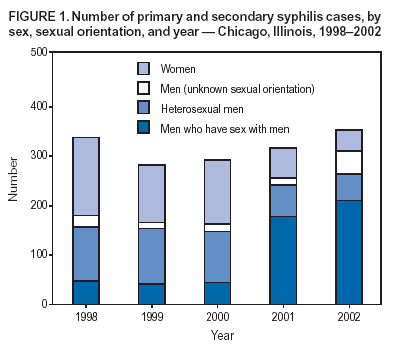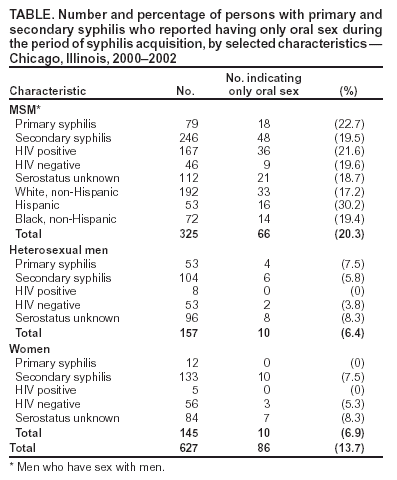 |
|
|
|
|
|
|
| ||||||||||
|
|
|
|
|
|
|
||||
| ||||||||||
|
|
|
|
|
Persons using assistive technology might not be able to fully access information in this file. For assistance, please send e-mail to: mmwrq@cdc.gov. Type 508 Accommodation and the title of the report in the subject line of e-mail. Transmission of Primary and Secondary Syphilis by Oral Sex --- Chicago, Illinois, 1998--2002During 1998--2002, the STD/HIV Prevention and Care Program of the Chicago Department of Public Health (CDPH) recorded 1,582 cases of primary and secondary (P&S) syphilis, the most of any U.S. city (1). Although case numbers and overall rates remained stable in Chicago during this period, patterns of transmission changed substantially. Throughout most of the 1990s, P&S syphilis was reported almost exclusively among heterosexuals. During 1998--2000, however, men who have sex with men (MSM) accounted for approximately 15% of Chicago's P&S syphilis morbidity. Since 2001, MSM have accounted for nearly 60% of patients with P&S syphilis (Figure 1). During 2000--2002, CDPH conducted interviews with persons with syphilis; some MSM reported they had engaged in only oral sex and were surprised to have acquired syphilis. In response, CDPH began collecting information on oral sex from persons with syphilis. To assess the role of oral sex in the transmission of P&S syphilis in Chicago, CDPH analyzed surveillance data and interview responses. This report summarizes the results of these analyses, which suggested that a substantial proportion (13.7%) of syphilis cases were attributed to oral sex, particularly among MSM. Persons who are not in a long-term monogamous relationship and who engage in oral sex should use barrier protection (e.g., male condoms or other barrier methods) to reduce the risk for sexually transmitted disease (STD) transmission. CDPH staff interviewed persons with syphilis to ensure adequacy of treatment for patients and their sex partners and to provide STD/human immunodeficiency virus (HIV) education and other testing and treatment services. Interviewers obtained demographic data (i.e., sex, age, race/ethnicity, and sexual orientation) and risk-behavior information (i.e., sexual behavior, number and sex of sex partners, venues for meeting partners, and self-reported HIV status). During the interviews, CDPH staff determined whether oral sex was the only sexual exposure the patient reported during the period of syphilis acquisition. Persons were asked about the type of sexual contact during the interval in which they likely acquired syphilis. This period usually is considered to be 3 months before treatment for primary syphilis and 6 months for secondary syphilis. Surveillance DataDuring 1998--2002, the number of reported cases of P&S syphilis in Chicago ranged from 338 to 353 cases annually; overall rates per 100,000 population ranged from 11.8 to 12.2. Rates declined 68% among women, from 9.2 to 2.9, and increased 50% among men, from 14.7 to 22.1. Of the 1,582 persons with P&S syphilis, 948 (60%) were heterosexuals, and 524 (33%) were MSM. Approximately 90% of heterosexuals were non-Hispanic black. An estimated 54% of MSM were non-Hispanic white, 26% were non-Hispanic black, and 13% were Hispanic. Rates declined by 31% among non-Hispanic black men and by 67% among non-Hispanic black, non-Hispanic white, and Hispanic women; rates increased among non-Hispanic white and Hispanic men (469% and 462%, respectively) (Figure 2). HIV-infection rates for persons with syphilis varied by sex and sexual orientation. In 2001 and 2002, among persons with P&S syphilis, less than 10% of heterosexuals and approximately half of MSM were HIV infected. Interview DataDuring 2000--2002, of 962 persons with P&S syphilis, data were available for 627 (65.2%); 325 (51.8%) were MSM, 157 (25.0%) were heterosexual men, and 145 (23.1%) were heterosexual women. Overall, 86 (13.7%) persons indicated that oral sex was their only sexual exposure during the period they likely acquired syphilis: 66 (20.3%) of 325 MSM, 10 (6.4%) of 157 heterosexual men, and 10 (6.9%) of 145 heterosexual women (p<0.0001) (Table). During the period of syphilis acquisition among the 325 MSM, oral sex was the only sexual exposure reported by 18 (22.7%) of 79 with primary syphilis, 48 (19.5%) of 246 with secondary syphilis, 36 (21.6%) of 167 with HIV infection, nine (19.6%) of 46 without HIV infection, and 21 (18.7%) of 112 with unknown HIV status. Thirty-three (17.2%) of 192 non-Hispanic white MSM, 16 (30.2%) of 53 Hispanic MSM, and 14 (19.4%) of 72 non-Hispanic black MSM reported having only oral sex during the period in which they likely acquired syphilis. When compared with heterosexual men and women, respectively, MSM were 3.8 and 3.4 times more likely to report only oral sex during the period of syphilis acquisition. Reported by: C Ciesielski, MD, I Tabidze, MD, C Brown, MBA, Chicago Dept of Public Health, Illinois. Div of Sexually Transmitted Diseases Prevention, National Center for HIV, STD, and TB Prevention, CDC. Editorial Note:The findings in this report suggest that during 2000--2002, 13.7% of P&S syphilis cases in Chicago were attributed to oral sex, including 20.3% of cases among MSM. Other reports also have associated oral sex with transmission of syphilis (2); one third of MSM who were involved in syphilis outbreaks in Brighton and Manchester, United Kingdom, acquired syphilis through oral sex (3). Syphilitic lesions develop at the site of syphilis infection within 10--90 days (median: 21 days), and lesions on the lips, tongue, and oral mucosa have been commonly described. During the secondary stage of syphilis, mucous patches, which have high concentrations of Treponema pallidum and are extremely infectious, might develop in the mouth. Syphilis in the oral cavity often is asymptomatic or subclinical and can be mistaken by patients for apthous ulcers or herpes, thereby delaying curative treatment and allowing ongoing transmission. Because the risk for HIV transmission through oral sex is much lower than the risk through anal or vaginal sex (4), persons might mistakenly consider unprotected oral sex (i.e., without a condom) to be a safe or no-risk sexual practice and adopt oral sex as a replacement for higher-risk behaviors. Condoms rarely are used for oral sex. Of an estimated 1,000 MSM in Chicago who stated that they had engaged in oral sex during the preceding 60 days, more than 75% never used condoms for either oral insertive or oral receptive sex (CDPH, unpublished data, 2003). Oral syphilitic lesions disrupt the protective epithelial barrier and recruit HIV target cells, increasing the risk for HIV transmission (5). Although oral sex might carry a lower risk for transmitting HIV than other forms of sex, repeated unprotected exposures, especially in the presence of syphilitic lesions, represent a substantial risk for HIV transmission. Syphilis might also increase progression of HIV disease (6,7). The findings in this report are subject to at least one limitation. The data might underestimate the role of oral sex in syphilis transmission because most persons who reported engaging in anal and vaginal sex also reported engaging in oral sex. Transmission was attributed to oral sex in only the 14% of cases in which oral sex was the only sexual exposure reported during the interval when syphilis likely was acquired. Some men who engaged in only oral sex believed that they were practicing safe sex and were surprised when they received a syphilis diagnosis. These data underscore the need for educating sexually active persons regarding the risk for syphilis transmission through oral sex. That syphilis might hasten the progression of HIV disease should provide a further motivation for MSM, especially HIV-infected MSM, to avoid syphilis acquisition. Persons who are not in a long-term monogamous relationship and who engage in oral sex should use barrier protection (e.g., male condoms or other barrier methods) to reduce the risk for STD and HIV transmission. References
Figure 1  Return to top. Figure 2  Return to top. Table  Return to top.
Disclaimer All MMWR HTML versions of articles are electronic conversions from ASCII text into HTML. This conversion may have resulted in character translation or format errors in the HTML version. Users should not rely on this HTML document, but are referred to the electronic PDF version and/or the original MMWR paper copy for the official text, figures, and tables. An original paper copy of this issue can be obtained from the Superintendent of Documents, U.S. Government Printing Office (GPO), Washington, DC 20402-9371; telephone: (202) 512-1800. Contact GPO for current prices. **Questions or messages regarding errors in formatting should be addressed to mmwrq@cdc.gov.Page converted: 10/21/2004 |
|||||||||
This page last reviewed 10/21/2004
|